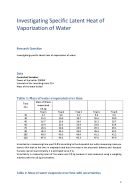‘Investigating wires’
(D, DCP and CE)
Determining how the length of a nichrome wire changes the resistance
Introduction:
Electrical resistance is a ratio of the degree to which an object opposes an electric current through it. It can also be defined as the ratio of voltage per unit current through it, R=V/I. The unit of electrical resistance is the ohm (Ω). Resistance can be found using the two following formulas.
Resistance= (Potential Difference ÷ Current) ---> (which is more known as Ohm’s law) where the potential difference is measured in Volts (V) and the current can be measured in Amps (A). Another way the resistance can be found is by using the formula R= (L)/ A. This is where the resistance (R) is related to: cross- sectional area (A), length (L) and material of the wire as R ∝ L/A. The constant of proportionality is called the resistivity ().
So R= (L)/ A
So for our theory work for this experiment, we know that R ∝ L/A. Therefore let’s say that by assuming the wire follows Ohm's Law, the resistance of a wire is directly proportional to its length therefore doubling the length will double the resistance of the wire. However when the length of the wire is doubled, its cross-sectional area is halved. (Assuming the volume of the nichrome wire remains constant and of course that the wire is a cylinder if we zoom in.) As resistance is inversely proportional to the cross-sectional area, halving the area leads to doubling the resistance. The combined effect of doubling the length and halving the cross-sectional area is that the original resistance of the wire has been quadrupled.
However in this experiment we will mainly be working with Ohm’s law (V=IR) for our calculations in order to see how the length of a nichrome wire affects the resistance.
Aim-
The aim of this experiment is to primarily investigate how varying the length of a nichrome wire alters it’s resistive power. Electrical resistance is a ratio of the degree to which an object opposes an electric current through it. It can also be defined as the ratio of voltage per unit current through it, R=V/I. We know that the resistance in metals is mainly caused by the collisions of numerous electrons which are constantly vibrating and flowing through the external circuit. And as the resistance in metals is caused by the collisions of electrons as well as the lattice protons in the metal conductor, changing the length of the nichrome wire would most certainly vary the resistance chiefly due to the increase in collision frequency.







